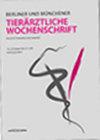Exploring PMCA as a potential in-vitro alternative method to mouse bioassays for the highly sensitive detection of BSE prions
IF 0.6
4区 农林科学
Q4 VETERINARY SCIENCES
Berliner und Munchener tierarztliche Wochenschrift
Pub Date : 2018-06-26
DOI:10.2376/0005-9366-18021
引用次数: 3
Abstract
Classical bovine spongiform encephalopathy (C-BSE) belongs to the transmissible spongiform encephalopathies (TSE), which are also designated prion diseases since they are caused by the conversion of the host-encoded cellular prion protein PrPC to its pathological isoform PrPTSE. BSE carries a zoonotic potential as BSE prions cause variant Creutzfeldt-Jakob disease in humans. To date, C-BSE infectivity can only be detected by bioassay, e.g. highly sensitive bovine PrP transgenic mice (e.g. Tgbov XV mice). Recently, highly sensitive in-vitro prion seeding activity assays, such as the Protein Misfolding Cyclic Amplification (PMCA), have been developed, which work particularly well for the template-assisted prion conversion of scrapie prions, while a similarly efficient bovine C-BSE-prion amplification remained unavailable. In the here described study, we have therefore compared the analytical sensitivities of the transgenic Tgbov XV mouse bioassay and our C-BSE PMCA protocol by analysing serial dilutions of a BSE-positive bovine brainstem homogenate pool. As both methods were shown to possess comparable sensitivities, we propose the C-BSE PMCA as a potential in-vitro replacement method, allowing the reduction and refinement of mouse bioassays for the detection of cattle derived classical BSE prions by reducing them to only specific analytical applications.探索PMCA作为一种潜在的体外替代方法,用于高灵敏度检测疯牛病朊病毒的小鼠生物测定
经典牛海绵状脑病(C-BSE)属于传染性海绵状脑病(TSE),也被称为朊病毒病,因为它们是由宿主编码的细胞朊蛋白PrPC转化为其病理亚型PrPTSE引起的。疯牛病具有人畜共患的潜力,因为疯牛病朊病毒在人类中引起变异型克雅氏病。迄今为止,C-BSE传染性只能通过生物测定来检测,例如,高度敏感的牛PrP转基因小鼠(例如Tgbov XV小鼠)。最近,高灵敏度的体外朊病毒种子活性测定,如蛋白质错误折叠循环扩增(PMCA),已经开发出来,特别适用于痒病朊病毒的模板辅助朊病毒转化,而同样有效的牛c - bse朊病毒扩增仍然不可用。因此,在本文所描述的研究中,我们通过分析疯牛病阳性牛脑干匀浆池的一系列稀释度,比较了转基因Tgbov XV小鼠生物测定法和我们的C-BSE PMCA方案的分析敏感性。由于这两种方法都具有相当的灵敏度,我们提出C-BSE PMCA作为一种潜在的体外替代方法,允许减少和改进用于牛源性经典疯牛病朊病毒检测的小鼠生物测定方法,将其减少到仅用于特定的分析应用。
本文章由计算机程序翻译,如有差异,请以英文原文为准。
求助全文
约1分钟内获得全文
求助全文
来源期刊
CiteScore
0.90
自引率
0.00%
发文量
0
审稿时长
18-36 weeks
期刊介绍:
The Berliner und Münchener Tierärztliche Wochenschrift is an open access, peer-reviewed journal that publishes contributions on all aspects of veterinary public health and its related subjects, such as epidemiology, bacteriology, virology, pathology, immunology, parasitology, and mycology. The journal publishes original research papers, review articles, case studies and short communications on farm animals, companion animals, equines, wild animals and laboratory animals. In addition, the editors regularly commission special issues on topics of major importance. The journal’s articles are published either in German or English and always include an abstract in the other language.

 求助内容:
求助内容: 应助结果提醒方式:
应助结果提醒方式:


